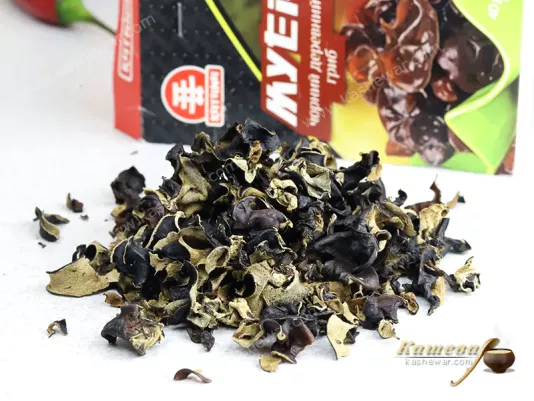Funchoza with Beef and Vegetables
Funchoza with Beef and Vegetables – Chinese recipe, very simple and very quick to prepare.

Muer is a wood ear mushroom that looks brittle and dark when dried but comes to life upon contact with water, becoming firm and smooth. I appreciate it for its versatility and soft, almost neutral aroma that allows for dishes with diverse flavor accents. Over the years of cooking, I’ve learned how important it is to maintain the right water ratio during soaking: too much makes the muer slippery, too little leaves it hard in the center. After rehydration, the mushroom should be thoroughly dried so it doesn’t thin the sauce. In my practice, muer often serves as a natural thickener in stir-fries or soups. It should be added near the end of cooking, when other ingredients are almost ready, ensuring a perfectly balanced texture and a rich yet light dish.
When choosing muer, I always pay attention to color and shape. A quality mushroom has a uniform dark brown or black hue without light spots, which may indicate mold or improper drying. The texture of dried muer should be firm but not crumbly, and the edges slightly wavy. From experience, I know that if the mushroom is too shiny, additives may have been used to enhance its appearance, and it’s best to avoid such products. For storage, muer should be kept in a tightly sealed jar in a dark place, away from moisture and sunlight. Humid air makes it prone to spoilage, so I always place a small packet of food-safe desiccant inside. When buying by weight, it’s worth smelling – the scent should be clean, with a light woody note. Old muer smells musty and loses both color and shape during soaking. I’ve noticed it keeps its best qualities for about a year, after which it gradually dulls and loses elasticity.
Before cooking, I always soak muer in cool water for 20-30 minutes – enough for the mushrooms to fully open. Hot water speeds up the process but makes the texture too soft and the flavor watery. Once the muer softens, I drain the water and gently rinse each piece, as small bits of bark or sand can remain between the petals. I always trim the tough base – it’s hard and doesn’t cook through. If the mushrooms are large, I cut them with scissors into strips or squares, depending on the dish. For salads, I leave larger pieces; for soups, smaller ones. Once I tried blending muer, but the result was poor – the texture lost its firmness. Now I only use a knife or kitchen scissors. It’s also important to squeeze out excess water thoroughly; otherwise, during frying, the mushroom releases moisture and stews instead of searing. This simple attentiveness prevents a spoiled texture and preserves a rich flavor.
After preparation, the most important thing is not to overcook muer. Its fibrous structure reacts quickly to heat, so I always cook it over medium heat, adding it at the very end. If boiled for more than three minutes, it becomes too soft and loses its natural crunch. In stir-fries, I add it after the vegetables, when the sauce begins to thicken – that way, the mushroom absorbs the aroma without releasing moisture. In soups, I add it 5-7 minutes before finishing, just to warm it through. For steamed or baked dishes, it’s important not to exceed 180°C (356°F), or the edges will dry out while the center remains damp. I’ve noticed muer acts like a sponge – it retains the juices of meat or vegetables if not overdried. So the main rule is short cooking at a stable temperature. If you need to reheat a dish with muer, it’s best to do so in a water bath or under a lid; otherwise, the mushroom becomes rubbery. Keeping this balance ensures a pleasant, springy texture appreciated even by the most demanding gourmets.
Muer has a neutral flavor, so its strength lies in highlighting other ingredients. I often combine it with ginger, garlic, and soy sauce – this trio creates depth without excessive sharpness. For a milder taste, I add sesame or peanut oil, a bit of rice vinegar, or lemon juice – they refresh the dish. In warm salads, muer pairs well with carrot, cucumber, and green onion, while in hot dishes it complements chicken or beef. One secret I’ve learned through practice: don’t mix muer with overly aromatic spices like cardamom or cloves, as they overpower its subtle profile. If you want spiciness, it’s better to use a pinch of chili or a few drops of pepper sauce. For thick sauces, I recommend adding a little starch or broth – muer holds structure well, creating a natural tenderness. When preparing a large dinner, I often pair muer with udon noodles or rice; it gives the dish textural harmony and lightness without excessive seasoning.
The most common mistake is soaking or boiling it for too long. I’ve often seen mushrooms left in water overnight turn into a slippery mass that loses shape during cooking. That’s why I always time it and never exceed half an hour. The second mistake is skipping rinsing – bark residue adds bitterness that can’t be fixed. Another risk is adding muer too early during frying, causing it to absorb excess oil and become tough. I intentionally add it later to keep it tender. If a dish is oversalted, you can balance the flavor by adding some boiled muer without seasoning – it absorbs excess saltiness. For storage, it’s important not to leave rehydrated mushrooms in water for over a day; even in the fridge, they quickly develop an unpleasant smell. I keep them in a sealed container wrapped in a paper towel for no more than two days. Over the years, I’ve found that quality muer always has a firm texture, even color, and a pleasant, slightly woody aroma – these are the signs I check before serving the finished dish.